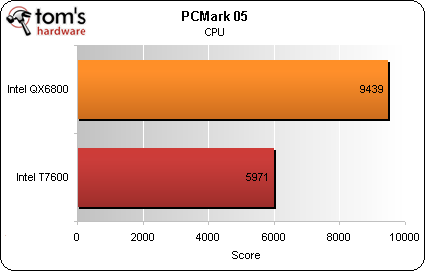Can CPUs Make PCs Faster & Quieter?
How (and What) We Tested
For each of the two builds described in the preceding sections, we subjected both to the same battery of tests and benchmarks, as follows:
- PCMark05 to get a sense of each build's overall computing power and capabilities;
- 3DMark05 to get a sense of each build's graphics handling capabilities;
- Sound measurements in various positions to get a sense of the noise output from each built, and the impact of case and orientation on audible sound emissions.
Benchmarks And Results
We'll describe the benchmarks we run one at a time, followed by a table of results from our test builds for that benchmark, along with the conclusions we drew from those results, as well as any observations we made along the way. We've been running some of these benchmarks (or variants thereof) long enough that these observations may often be more interesting than conclusions to which the results lead us, though it's clear that price and overall performance are strongly related, as you'd expect (or hope) them to be. Interestingly, our test results also show that the noise increment involved in moving up from a T7600 to a QX6800 is nowhere near as onerous as you might be inclined to think.
PCMark05
PCMark05 is a set of synthetic benchmarks that simulate various kinds of workloads for PCs. Though these ratings do not necessarily reflect real-life performance, they do provide a useful basis for comparing across multiple systems, such as the two builds we put together for this story. In the table that follows, we report measurements for overall performance (called PCMarks, a common mechanism for comparing and one-upping systems on the Web), CPU, memory, Graphics, HD general usage, all of which are relevant to media-PC performance.
Looking at these results, two things are clear: first, the quad-core processor outperforms its mobile dual-core counterpart. The differences are most extreme where the differences between two motherboard/CPU/RAM combinations are most accentuated - namely, CPU (58% delta) and Memory (28% delta) scores. It's interesting that hard disk speeds don't vary much at all (less than 1%) between the ICH7-M on the Asus motherboard and the ICH9 on the Gigabyte motherboard. Because the hard drives were the same for both builds, we feel fairly confident in attributing similar levels of performance to the on-board controllers as well. It's also interesting that the faster, more capable QX6800 can squeak an additional 6.7% of performance out of the same graphics card as compared to the T7600. Are these differences worth an extra thousand smackers? Only for those whose need for speed exceeds their budgetary limitations, we suspect.
Get Tom's Hardware's best news and in-depth reviews, straight to your inbox.




